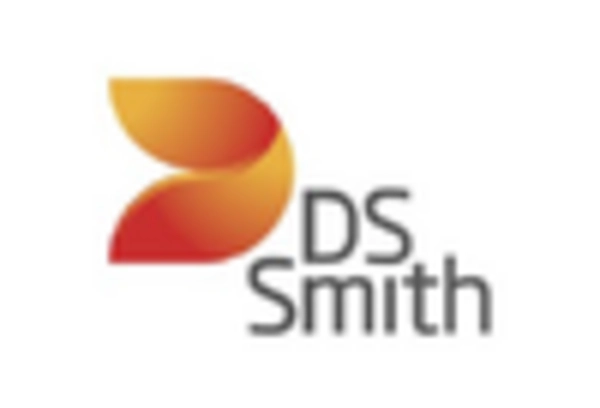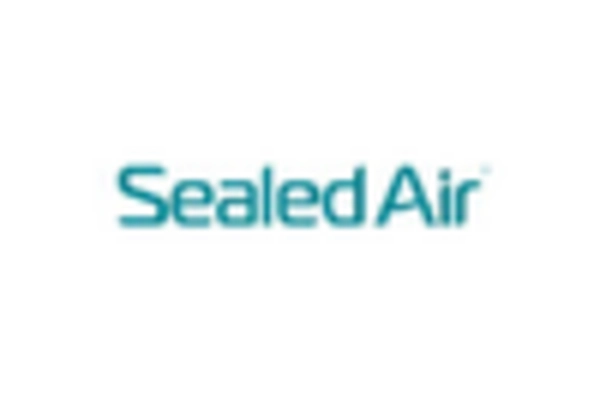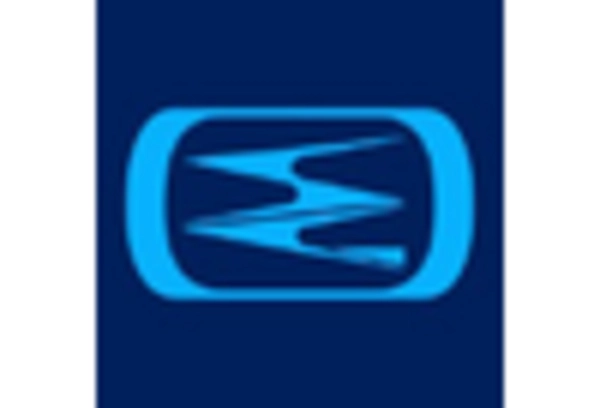Growing Environmental Awareness
There is a notable increase in environmental awareness among consumers, which is significantly influencing the Sustainable Packaging Material Market. As individuals become more conscious of their ecological footprint, they are actively seeking products that utilize sustainable packaging. This shift in consumer behavior is prompting manufacturers to adopt eco-friendly materials and practices. Recent surveys indicate that over 70% of consumers are willing to pay a premium for products packaged in sustainable materials. This growing demand is driving companies to innovate and invest in sustainable packaging solutions, thereby expanding the market. The emphasis on reducing plastic waste and promoting circular economy principles is likely to further propel the adoption of sustainable packaging materials across various sectors.
Regulatory Pressures and Compliance
The Sustainable Packaging Material Market is increasingly shaped by regulatory pressures aimed at reducing environmental impact. Governments around the world are implementing stringent regulations to limit plastic usage and promote sustainable alternatives. For instance, several countries have introduced bans on single-use plastics, compelling businesses to seek sustainable packaging solutions. This regulatory landscape is creating a sense of urgency among manufacturers to comply with new standards, thereby driving the demand for sustainable materials. Market analysis suggests that compliance with these regulations could lead to a market growth rate of approximately 12% in the coming years, as companies adapt to the evolving legal framework surrounding packaging materials.
Corporate Sustainability Initiatives
Many corporations are increasingly integrating sustainability into their business strategies, which is positively impacting the Sustainable Packaging Material Market. Companies are recognizing that adopting sustainable packaging not only enhances their brand image but also meets the expectations of environmentally conscious consumers. A significant number of Fortune 500 companies have set ambitious sustainability goals, including reducing plastic usage and increasing the use of recyclable materials. This trend is reflected in the market, where the demand for sustainable packaging solutions is expected to rise by approximately 15% annually over the next few years. As businesses strive to align with sustainability targets, the market for sustainable packaging materials is likely to expand, driven by corporate commitments to environmental stewardship.
Innovation in Supply Chain Management
The Sustainable Packaging Material Market is also benefiting from innovations in supply chain management that prioritize sustainability. Companies are increasingly adopting practices that reduce waste and enhance the efficiency of packaging processes. This includes the use of sustainable materials sourced from responsible suppliers, as well as the implementation of circular economy principles that promote recycling and reuse. Recent studies indicate that companies that integrate sustainable practices into their supply chains can reduce costs by up to 30%, while also improving their environmental impact. As more businesses recognize the financial and ecological benefits of sustainable supply chain management, the demand for sustainable packaging materials is expected to grow, further solidifying the market's trajectory.
Technological Advancements in Sustainable Materials
The Sustainable Packaging Material Market is witnessing a surge in technological innovations that enhance the performance and sustainability of packaging materials. Developments in bioplastics, for instance, have led to the creation of materials that not only decompose more efficiently but also maintain the integrity required for packaging. According to recent data, the market for bioplastics is projected to grow at a compound annual growth rate of approximately 20% over the next five years. This trend indicates a shift towards more eco-friendly alternatives, as companies increasingly invest in research and development to create sustainable solutions. Furthermore, advancements in recycling technologies are enabling the recovery of materials that were previously deemed non-recyclable, thereby expanding the scope of sustainable packaging options available in the market.

















Leave a Comment